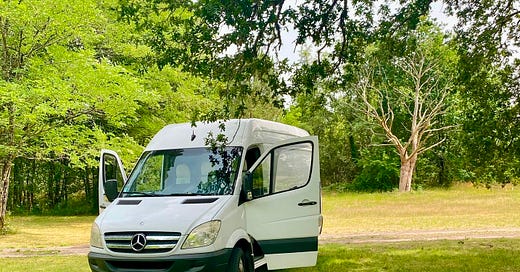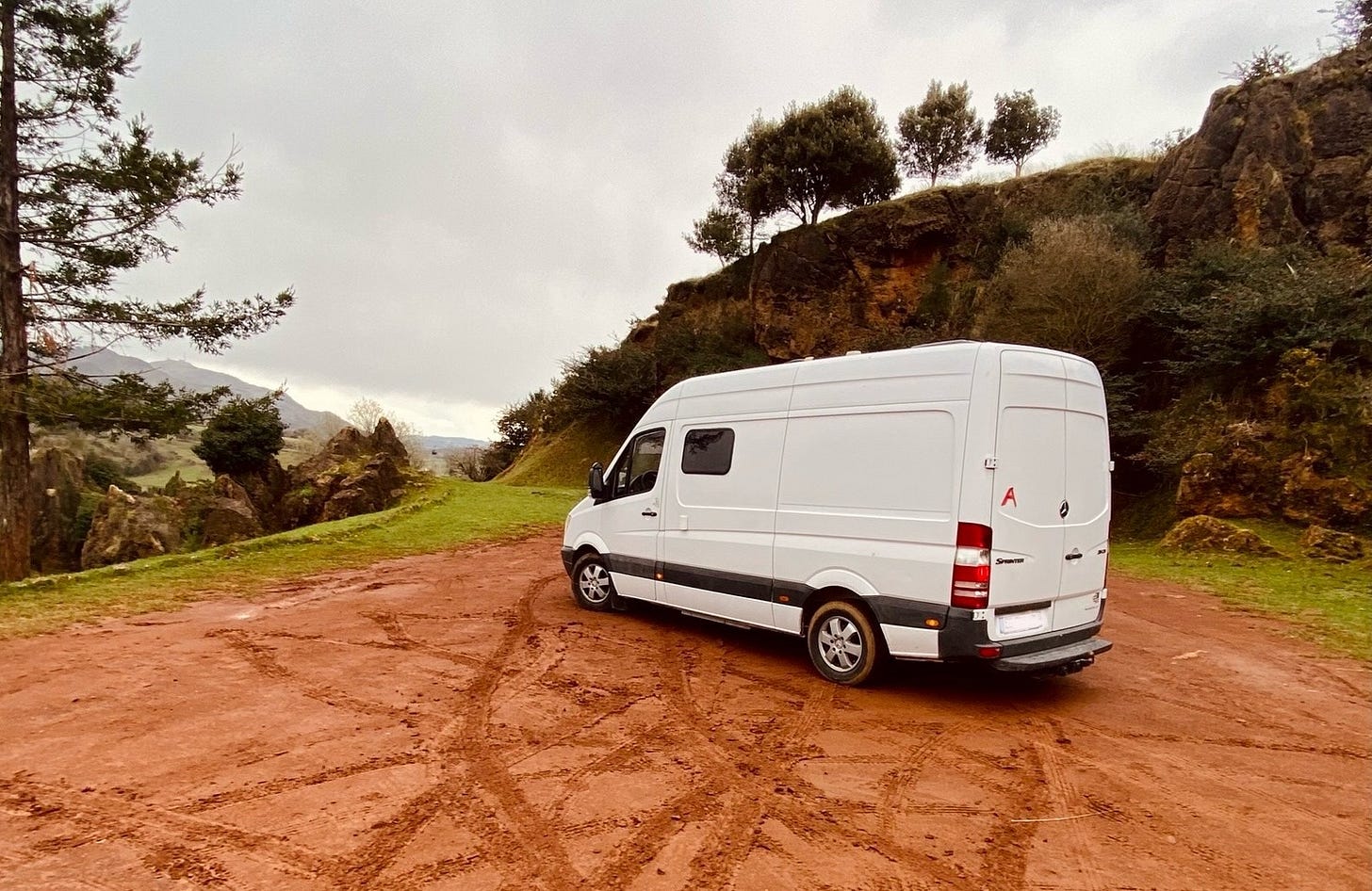This is how I’m spending my Saturday night, writing for you! I wouldn’t trade this life for anything.
Before moving into our van full-time, we had never owned or driven a cargo van before. Naturally, we knew nothing about vans or what to look for, so our very first factor was budget.
In full transparency, we had set ourselves a budget of 10,000€ tops. But as my dad and a guy I spoke to once told me, when buying a used vehicle, take out 10 to 15% of your budget for possible repairs because, as they put it, “No one sells a perfectly drivable second-hand vehicle just for the fun of it.” They all come with some defects, just pray for minor ones.
They weren’t wrong. Our first breakdown happened on our very first drive home: the alternator gave out. Luckily for us, it “only” cost 180€ to fix it (instead of replacing it).
So, when choosing our new home-to-be, money was a factor, but it wasn’t the only one. In fact, even if we’d allocated more cash to it, we wouldn’t have bought the newer version, we would’ve simply bought this version with fewer miles on it.
When you’re picking a van to live and travel in, especially across multiple countries, you want something you can rely on not just for a year, but for the long haul.
After digging through forums, Facebook groups, talking to experienced vanlifers, and comparing options, we landed on the 2009 Mercedes Sprinter II, short wheelbase (144).
Here’s why:
1. Reliability
Older Sprinters are known for their ability to hit well over 500,000 miles with proper maintenance. They’re built to work hard (think UPS, ambulances, towing etc), and that’s exactly what we needed, a van that can handle thousands of kilometers across different terrains without constantly throwing errors.
2. No eovercomplicated electronics
Modern vans (and cars) are overloaded with electronics, touchscreens, sensors, you name it. In fact, it’s not only modern vans, older ones come with some of those too. We’ve just changed our own set of sensors last week.
As a rule of thumb, we try to stay away from any vehicles that came out after 2012. They’re loaded with tech stuff. I hate tech stuff in the cars I drive. Plus, the more tech in a vehicle, the more there is to break. Our 2009 Sprinter is made simple, which means fewer things to fail and easier repairs when things go wrong, especially in rural and/or developing areas.
3. Open engine bay = Easy DIY maintenance
Our home on wheels has a proper old-school engine bay. We can actually see what’s what and work on most basic maintenance ourselves (with some assistance of course), without needing special diagnostic computers. I just did my first oil change ever, it was a breeze!
4. Power steering
We wanted a van that’s easy to maneuver, especially when parking in tight European cities (hello, Italy!), so power steering (like AC) was non-negotiable. Older vans often lack this, but the 2009 gives us that comfort while keeping everything else mechanical and simple.
If it wasn’t for this, we would’ve bought the older version (Sprinter I)
5. Manual transmission
We actively chose a manual gearbox because we spend a lot of time in the mountains. Manual gives better control on steep inclines, and it’s also more durable over time compared to some of the automatic options in newer vans.
That said, I don’t know if I’d do it again. Automatic transmission is usually a lot more comfortable on long drives, so yeah, worth considering next time.
6. AC!!
For a work van, ours came fully loaded, which was a nice bonus. Obviously this wasn’t planned. So our Sprinter got air conditioning, electric windows, cruise control, and even aluminum rims. Oh and custom seat protections!
7. A tow hitch that serves as a built-in rear bumper / protection
Pingu (that’s the nickname we gave our van) came with a tow hitch, which we mostly use as rear bumper protection. If someone taps us from behind, they hit the steel hitch, not our bodywork. Came in handy a couple of times already, and for parking (because we don’t have a backup parking camera, yet)
8. No side windows
We specifically wanted a panel van. Having no windows means no one can see inside, and we don’t need to fuss with curtains or blackout covers every time we park. It also makes the van less of a target for theft and easier to insulate. Win-win-win
9. Parts and relatively affordable repairs (if you know the right guy)
This generation of Sprinters has been used across Europe and beyond in every industry imaginable. This means parts are usually everywhere, and mechanics know these vans inside out. Used parts can also be easy to find, and repairs don’t require a Mercedes dealership (unlike some newer vans).
10. Reasonable fuel consumption
Considering its size and age, the fuel consumption is surprisingly decent. The 2.1 CDI engine is powerful enough to carry a full camper build without guzzling fuel like some bigger engines. We also don’t drive fast so that helps, a lot!
11. Less emissions than the older version
This generation hits a sweet spot for emissions. It’s cleaner than the early 2000s models, but it avoids the nightmare modern systems like AdBlue errors, and endless emissions warnings that newer vans constantly deal with. Once again, we did have a faulty gas sensor but that’s behind us now. I bought the parts (2 of them) and my mechanic changed them for us for free (great guy!).
12. Comfortable but still simple
It’s not a luxury vehicle, but compared to older generations, it’s so comfortable to drive: better seats, decent soundproofing (which we improved) and a more refined driving experience. Sprinters are mostly used as luxury hotel shuttles, and most artists and rockstars ride in those before shows.
Despite these amazing features, the Sprinter still feels like a proper van, not a fragile electronic bubble.
13. Price
We paid 9100€ for our Sprinter, + 3k in maintenance and new parts of all sorts, so overall cost us 12k€. For a van with a solid reputation, loads of life left, new parts and sensors and the features that actually matter for long-term travel, our sprinter is a gem. Newer vans would have cost double or triple, and we’d trust them less.
When you live on the road, you want a van that works with you, not against you.
Our Pingu is just that.
Thanks for reading!
T_







This is really insightful. Budgeting for repairs upfront is such a smart approach. What’s been the biggest lesson from van life so far?
Really useful insights, thank you! We're looking to swap our Transit custom for bigger for longer trips and haven't decided what to go for yet so this is good to know!
100% agree with you about the tech! I was recently between cars (a 2013 skoda and a 2011 vauxhall) and had to use a hire car from the insurance company. It was a 2023 model and I hated it. Far too many screens and too much tech, I was so happy to go back to a 2011 model- as long as it has an aux port I'm happy to be honest.